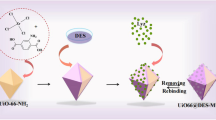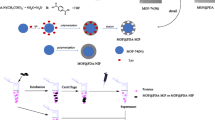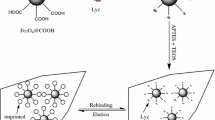Abstract
A magnetized molecularly imprinted polymer (MIP) was prepared via a surface-imprinting technique. An allyl-based deep eutectic solvent was chosen as the functional monomer to obtain the polymer for specific recognition of lysozyme. It was deposited on silica-coated magnetite nanoparticles. The structure of the polymer was confirmed by X-ray diffraction, Fourier transform infrared spectrometry, transmission electron microscopy, thermogravimetric analysis and vibrating sample magnetometry. The maximum binding capacity of the imprinted polymer is found to be 108 mg·g−1, which is higher than that of non-imprinted polymer. Compared to reference proteins such as cytochrome C, bovine hemoglobin and bovine serum albumin, the MIP shows favorable selectivity for lysozyme. Besides, the imprinted polymer can be further used to specifically recognize lysozyme from the protein mixture and chicken egg white. Reusability studies demonstrate that the polymer can be recycled four times without significant loss of adsorption capacity. The LOD of the method is 12.8 μg·mL−1. The relative standard deviations (for n = 3) are 1.38% for precision and 2.76% for repeatability. Its facile synthesis, high adsorption performance and excellent selectivity to capture lysozyme make this polymer an attractive candidate to be applied in biomacromolecular purification.

Magnetic molecularly imprinted polymer (MIP) based on deep eutectic solvent as functional monomer was fabricated and applied for the specific recognition of lysozyme. The MIP exhibits high adsorption capacity and excellent selectivity for lysozyme.







Similar content being viewed by others
References
Zhang RL, Xu S, Luo J, Liu XY (2015) Molecularly imprinted photo-sensitive polyglutamic acid nanoparticles for electrochemical sensing of hemoglobin. Microchim Acta 182:175–183
Niu M, Pham-Huy C, He H (2016) Core-shell nanoparticles coated with molecularly imprinted polymers: a review. Microchim Acta 183:2677–2695
Li QR, Yang KG, Li SW, Liu LK, Zhang LH, Liang Z, Zhang YK (2016) Preparation of surface imprinted core-shell particles via a metal chelating strategy: specific recognition of porcine serum albumin. Microchim Acta 183:345–352
Chen LX, Wang XY, Lu WH, Wu XQ, Li JH (2016) Molecular imprinting: perspectives and applications. Chem Soc Rev 45:2137–2211
Wu T, Wei XP, Ma XH, Li JP (2017) Amperometric sensing of L-phenylalanine using a gold electrode modified with a metal organic framework, a molecularly imprinted polymer, and β-cyclodextrin-functionalized gold nanoparticles. Microchim Acta 184:2901–2907
Wang CY, Ye XX, Wang ZG, Wu T, Wang YY, Li CY (2017) Molecularly imprinted photo-electrochemical sensor for human epididymis protein 4 based on polymerized ionic liquid hydrogel and gold nanoparticle/ZnCdHgSe quantum dots composite film. Anal Chem 89:12391–12398
Gao W, Pi FW, Zhang HX, Sun JD, Zhang YZ, Sun XL (2017) A novel molecularly imprinted electrochemical sensor modified with carbon dots, chitosan, gold nanoparticles for the determination of patulin. Biosens Bioelectron 98:299–304
Piletska EV, Abd BH, Krakowiak AS, Parmar A, Pink DL, Wall KS, Wharton L, Moczko E, Whitcombe MJ, Karim K (2015) Magnetic high throughput screening system for the development of nano-sized molecularly imprinted polymers for controlled delivery of curcumin. Analyst 140:3113–3120
Peng S, Wang YH, Li N, Li C (2017) Enhanced cellular uptake and tumor penetration of nanoparticles by imprinting the “hidden” part of membrane receptors for targeted drug delivery. Chem Commun 53:11114–11117
Wang J, Zhu MY, Shen XJ, Li SJ (2015) A cascade-reaction nanoreactor composed of a bifunctional molecularly imprinted polymer that contains Pt nanoparticles. Chem-Eur J 21:7532–7539
Zhang XJ, Li CX, Yan YS, Pan JM, Xu PP, Zhao XH (2010) A Ce3+-imprinted functionalized potassium tetratitanate whisker sorbent prepared by surface molecularly imprinting technique for selective separation and determination of Ce3+. Microchim Acta 169:289–296
Li HF, Xie T, Ye LL, Wang YW, Xie CG (2017) Core-shell magnetic molecularly imprinted polymer nanoparticles for the extraction of triazophos residues from vegetables. Microchim Acta 184:1011–1019
Guo JX, Wang YZ, Liu YJ, Zhang CJ, Zhou YG (2015) Magnetic-graphene based molecularly imprinted polymer nanocomposite for the recognition of bovine hemoglobin. Talanta 144:411–419
Wei JR, Ni YL, Zhang W, Zhang ZQ, Zhang J (2017) Detection of glycoprotein through fluorescent boronic acid-based molecularly imprinted polymer. Anal Chim Acta 960:110–116
Guo LX, Hu XL, Guan P, Du CB, Wang D, Song DM, Gao XM, Song RY (2015) Facile preparation of superparamagnetic surface-imprinted microspheres using amino acid as template for specific capture of thymopentin. Appl Surf Sci 357:1490–1498
Qin YP, Li DY, He XW, Li WY, Zhang YK (2016) Preparation of high-efficiency cytochrome c-imprinted polymer on the surface of magnetic carbon nanotubes by epitope approach via metal chelation and six-membered ring. ACS Appl Mater Interfaces 8:10155–10163
Zhang XY, Zhang N, Du CB, Guan P, Gao XM, Wang CY, Du YF, Ding SH, Hu XL (2017) Preparation of magnetic epitope imprinted polymer microspheres using cyclodextrin-based ionic liquids as functional monomer for highly selective and effective enrichment of cytochrome c. Chem Eng J 317:988–998
Zamora-Galvez A, Ait-Lahcen A, Mercante LA, Morales-Narvaez E, Amine A, Merkoci A (2016) Molecularly imprinted polymer-decorated magnetite nanoparticles for selective sulfonamide detection. Anal Chem 88:3578–3584
Dai QZ, Wang YZ, Xu W, Liu YJ, Zhou YG (2017) Adsorption and specific recognition of DNA by using imprinted polymer layers grafted onto ionic liquid functionalized magnetic microspheres. Microchim Acta 184:4433–4441
Abbott AP, Capper G, Davies DL, Rasheed RK, Tambyrajah V (2003) Novel solvent properties of choline chloride/urea. Chem Commun 8:70–71
Yang TX, Zhao LQ, Wang J, Song GL, Liu HM, Cheng H, Yang Z (2017) Improving whole-cell biocatalysis by addition of deep eutectic solvents and natural deep eutectic solvents. ACS Sustain Chem Eng 5:5713–5722
Song YX, Tang J, Hu JG, Yang H, Gu WM, Fu YN, Ji XB (2017) Interfacial assistant role of amine additives on zinc electrodeposition from deep eutectic solvents: an in situ X-ray imaging investigation. Electrochim Acta 240:90–97
Karimi M, Shabani AMH, Dadfarnia S (2016) Deep eutectic solvent-mediated extraction for ligand-less preconcentration of lead and cadmium from environmental samples using magnetic nanoparticles. Microchim Acta 183:563–571
Xu KJ, Wang YZ, Li YX, Lin YX, Zhang HB, Zhou YG (2016) A novel poly(deep eutectic solvent)-based magnetic silica composite for solid-phase extraction of trypsin. Anal Chim Acta 946:64–72
Liang SR, Yan HY, Cao JK, Han YH, Shen SG, Bai LG (2017) Molecularly imprinted phloroglucinol–formaldehyde–melamine resin prepared in a deep eutectic solvent for selective recognition of clorprenaline and bambuterol in urine. Anal Chim Acta 951:68–77
Fu NJ, Li LT, Liu X, Fu NA, Zhang CC, Hu LD, Li DH, Tang BK, Zhu T (2017) Specific recognition of polyphenols by molecularly imprinted polymers based on a ternary deep eutectic solvent. J Chromatogr A 1530:23–24
Liu YJ, Wang YZ, Dai QZ, Zhou YG (2016) Magnetic deep eutectic solvents molecularly imprinted polymers for the selective recognition and separation of protein. Anal Chim Acta 936:168–178
Zhuravlev OE, Nikolskii VM, Voronchikhina LI (2013) Thermal stability of quaternary ammonium hexafl uorophosphates and Halides. Russ J Appl Chem + 86:824–830
Kan X, Zhao Q, Shao D, Geng Z, Wang Z, Zhu JJ (2010) Preparation and recognition properties of bovine hemoglobin magnetic molecularly imprinted polymers. J Phys Chem B 114:3999–4004
Wang YH, Duan HM, Li LL, Wang XJ, Li JB, Bu YN, Luo CN (2016) A chemiluminescence sensor for determination of lysozyme using magnetic graphene oxide multi-walled carbon nanotube surface molecularly imprinted polymers. RSC Adv 6:12391–12397
Ji SL, Li N, Shen Y, Li Q, Qiao J, Li ZB (2016) Poly (amino acid)-based thermoresponsive molecularly imprinted magnetic nanoparticles for specific recognition and release of lysozyme. Anal Chim Acta 909:60–66
Wang XJ, Dong SH, Bai Q (2014) Preparation of lysozyme molecularly imprinted polymers and purification of lysozyme from egg white. Biomed Chromatogr 28:907–912
Pan GQ, Guo QP, Cao CB, Yang HL, Li B (2013) Thermo-responsive molecularly imprinted nanogels for specific recognition and controlled release of proteins. Soft Matter 9:3840–3850
Zhang CJ, Wang YZ, Zhou YG, Guo JX, Liu YJ (2014) Silica-based surface molecular imprinting for recognition and separation of lysozymes. Anal Methods 6:8584–8591
Acknowledgements
The authors greatly appreciate the financial supports by the National Natural Science Foundation of China (No.21675048) and the Foundation for Innovative Research Groups of NSFC (Grant 21521063).
Author information
Authors and Affiliations
Corresponding author
Ethics declarations
The authors declare that they have no competing interests.
Electronic supplementary material
ESM 1
(DOCX 1.33 mb)
Rights and permissions
About this article
Cite this article
Xu, K., Wang, Y., Wei, X. et al. Preparation of magnetic molecularly imprinted polymers based on a deep eutectic solvent as the functional monomer for specific recognition of lysozyme. Microchim Acta 185, 146 (2018). https://doi.org/10.1007/s00604-018-2707-8
Received:
Accepted:
Published:
DOI: https://doi.org/10.1007/s00604-018-2707-8




